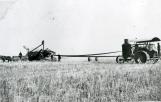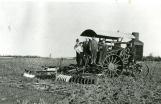1
The steam engine eventually took over from the horse as the power for farm equipment, and from there, the tractor.Steam engines were fueled by wood, hay or coal, and later tractors ran on kerosene and gas.
A short excerpt from the Steam Era.com website, talking about a Case steam engine says:
"From a 1907 Case catalog, a Saskatchewan farmer writes "that his Case engine will travel 2 ¼ to 2.1/2 mile per hour pulling a 12 bottom plow cutting 14 feet wide. That equaling 3.8 acres per hour and in a twelve hour day making allowance for reasonable delays averaging an estimated 30 to 40 acres. He also says plowing in heavier sod and breaking about 20-30 acres per day his 25HP Case uses from 2000 to 2400 lbs of coal and about 36 barrels of water."
See more at: http://www.steam-era.com/traction_engine_history.htm
Following are a variety of steam engines and tractors being operated by members of our original farm families.
3
Steam engines ran on a variety of fuels, but most often by wood, as it was often readily available on the farms.This photo shows Clarence Neis and a fireman, burning straw as fuel in their steam engine.
5
Here is Ceph Harris, with his water tank along side Jack Edward's steam engine.They and the equipment were part of Will Ferguson's Threshing outfit.
7
These men are threshing with a steam outfit, most likely in the early 1920's, or late teens.The outfit most likely belongs to William Ferguson, who owned the first steam threshing machine in the Nebraska district (near Mirror).
This photo shows L to R, the steam engine, with Will and Phil Ferguson on top, with a team of horses out front of them. Further to the right is the water wagon, with a set of three men behind, Earl Barnes, Ken McNeil and Clark Minnick. To their right, at the front of the threshing outfit are 3 other men, Bill Barns and Bill and Jack Edwards. The man on the far right is Art Gardener. (we're not completely sure the names match the correct men, as Earl Barns was mentioned twice, once before Ken McNeil, and once, after Clark Minnick)
The threshing process separates the grain, after it has been stooped and dried.
9
Elmer Cheever plowing with a six bottom plow and his Flour City tractor.The Flour City tractor was built to be a simple, efficient and serviceable farm tractor. It was developed in the very early 1900's, and ran on kerosene.
For an indepth look at the history of this tractor, you can visit:
http://www.buckleyoldengineshow.org/FlourCity/flourcity.htm
11
Alfred and Ed Buelow in this photo are plowing with a Case gas tractor around 1908.Note the cross mounted engine.
See additional details on the Case tractor and steam engines at:
http://www.ytmag.com/cgi-bin/ntracz.pl?m'case
13
Harrington's threshing outfit, powered by what we thought was a Rumley Oil Pull tractor, but has been identified as a 30-60 Hart Parr Tractor.Both tractors ran on Kerosene.
For history on The Rumley visit:
http://members.tripod.com/Rumelypull/RumelyINFO.html
For history on the Hart Parr visit:
http://www.asme.org/history/brochures/h190.pdf
and decide for yourself!






